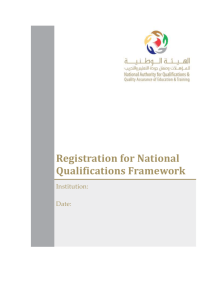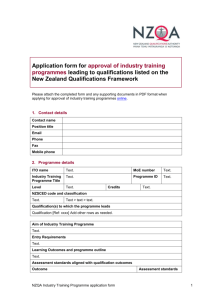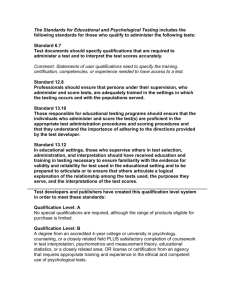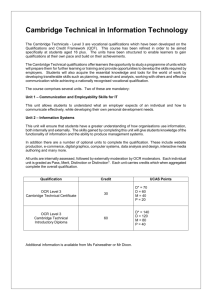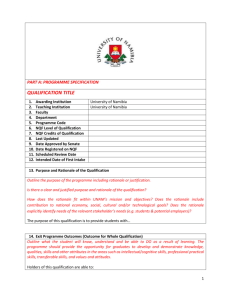Submission of a new programme
advertisement
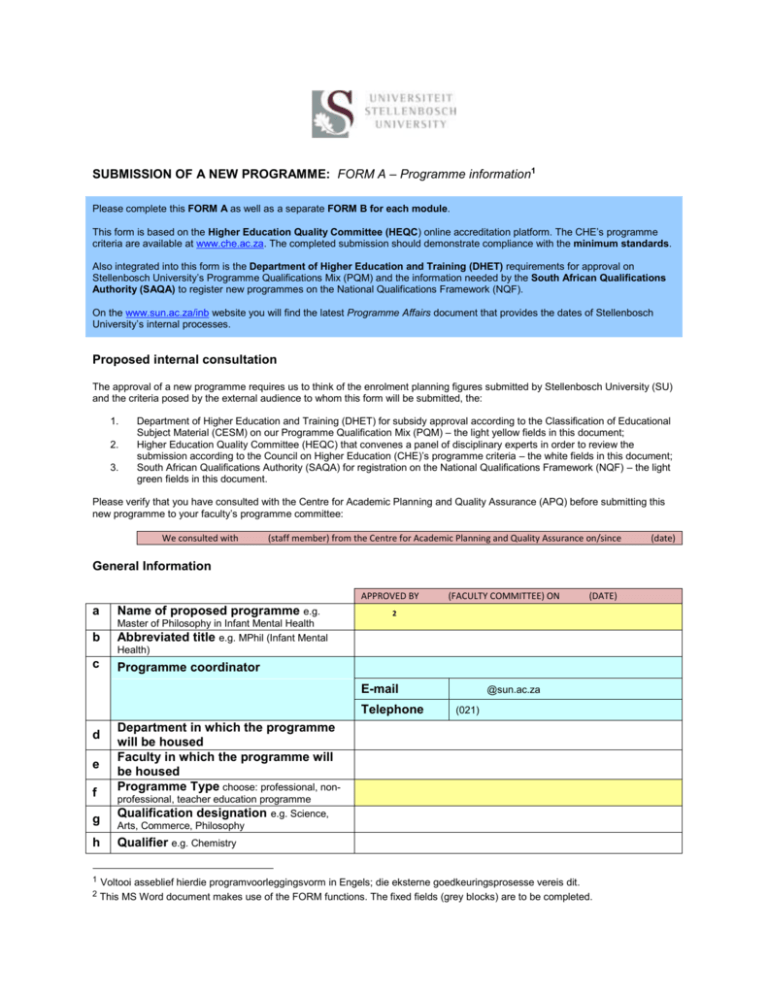
SUBMISSION OF A NEW PROGRAMME: FORM A – Programme information1 Please complete this FORM A as well as a separate FORM B for each module. This form is based on the Higher Education Quality Committee (HEQC) online accreditation platform. The CHE’s programme criteria are available at www.che.ac.za. The completed submission should demonstrate compliance with the minimum standards. Also integrated into this form is the Department of Higher Education and Training (DHET) requirements for approval on Stellenbosch University’s Programme Qualifications Mix (PQM) and the information needed by the South African Qualifications Authority (SAQA) to register new programmes on the National Qualifications Framework (NQF). On the www.sun.ac.za/inb website you will find the latest Programme Affairs document that provides the dates of Stellenbosch University’s internal processes. Proposed internal consultation The approval of a new programme requires us to think of the enrolment planning figures submitted by Stellenbosch University (SU) and the criteria posed by the external audience to whom this form will be submitted, the: 1. 2. 3. Department of Higher Education and Training (DHET) for subsidy approval according to the Classification of Educational Subject Material (CESM) on our Programme Qualification Mix (PQM) – the light yellow fields in this document; Higher Education Quality Committee (HEQC) that convenes a panel of disciplinary experts in order to review the submission according to the Council on Higher Education (CHE)’s programme criteria – the white fields in this document; South African Qualifications Authority (SAQA) for registration on the National Qualifications Framework (NQF) – the light green fields in this document. Please verify that you have consulted with the Centre for Academic Planning and Quality Assurance (APQ) before submitting this new programme to your faculty’s programme committee: We consulted with (staff member) from the Centre for Academic Planning and Quality Assurance on/since General Information APPROVED BY a Name of proposed programme e.g. b Master of Philosophy in Infant Mental Health Abbreviated title e.g. MPhil (Infant Mental Health) c Programme coordinator (FACULTY COMMITTEE) ON E-mail Telephone d e f g h 1 2 (DATE) 2 @sun.ac.za (021) Department in which the programme will be housed Faculty in which the programme will be housed Programme Type choose: professional, nonprofessional, teacher education programme Qualification designation e.g. Science, Arts, Commerce, Philosophy Qualifier e.g. Chemistry Voltooi asseblief hierdie programvoorleggingsvorm in Engels; die eksterne goedkeuringsprosesse vereis dit. This MS Word document makes use of the FORM functions. The fixed fields (grey blocks) are to be completed. (date) i Second Qualifier e.g. Organic Chemistry Note: Master’s and PhDs do not have 2nd qualifiers j programme in terms of one of the knowledge field categories in the list and write its corresponding number in the form field (01) Agriculture, Agricultural Operations and related sciences (02) Architecture and the Built Environment (03) Visual and Performing Arts (04) Business, Economics and Management Studies (05) Communication, Journalism and related studies (06) Computer and Information Sciences (07) Education (08) Engineering (09) Health Professions and related Clinical Sciences (10) Family Ecology and Consumer Sciences (11) Languages, Linguistics and Literature (12) Law (13) Life Sciences (14) Physical Sciences (15) Mathematics and Statistics (16) Military Sciences (17) Philosophy, Religion and Theology (18) Psychology (19) Public Management and Services (20) Social Sciences Majors/fields of study by 2nd order Classification of Educational Subject Matter (CESM) categories (1) (2) (3) (4) Classification of Educational Subject Matter (CESM) Please classify the new Note: For office use only by the Centre for Institutional Information k NQF level Please refer to the HEQSF for the l m Total number of credits Minimum duration FULL time years/ n Minimum duration PART time years/ o Site(s) of delivery Main campus, Tygerberg p q New qualification in new cell of grid Existing qualification in new cell of grid New qualification in approved cell of grid New qualification in approved cell but in new second order CESM category (5) Existing qualification in approved cell but in new second order CESM category (6) Change of name/title of existing Qualification (7) Other NQF levels 5 to 10 i.e. from HCert to PhD months months campus, Saldanha campus, Bellville Park campus Date by which you plan to start offering the programme Do you have regional clearance from UCT, CPUT, UWC? Brief justification of application Please justify why the Department of Higher Education and Training (DHET) should fund this programme in terms of our Programme Qualification Mix (PQM). Does this fit in with our enrolment planning targets? Please note that if this proposed programme does not form part of our existing PQM an additional business plan may have to be submitted to the DHET. 1. PROGRAMME DESIGN CRITERION 1 The programme is consonant with the institution's mission, forms part of institutional planning and resource allocation, meets national requirements, the needs of students and other stakeholders, and is intellectually credible. It is designed coherently, and articulates well with other relevant programmes, where possible. 1.1 How does this programme fit in with the mission and plan of the institution (and faculty)? Please refer directly to the Institutional Intent and Strategy and the strategic documents of your faculty. 1.2 Provide a rationale for this programme, taking into account the envisaged student intake and stakeholder needs. How does this programme address local, national and international needs, or the needs as articulated by the profession? Who are the students at which this programme is aimed? (b) International comparability Please provide a statement on how the qualification compares with or relates to similar qualifications or best practices or standards offered in other parts of the world. (Perhaps use the proposed programme name as a Google search term or visit the websites of peer universities.) Qualifications that are internationally comparable could assist in determining the articulation possibilities of the qualification with qualifications in other national and regional qualification frameworks. 1.3 Describe the articulation possibilities of this programme. Preceding Next level 1.4 Provide the names of the modules which constitute the programme - and for each course, specify: NQF level of the module Module name Credits per module Compulsory/ optional Year 1,2,3,4 Total credits per year 3rd order CESM category of module Learning activities – complete the following table for the whole programme: 1.5 Please note that: (a) SU only offers contact modules (b) For qualifications at NQF levels 5 and 6 the % contact time should be 30% (that is 360 learning hours) and for qualifications at NQF levels 7 and 8 the % of contact time should be 25% (that is 300 learning hours). Also make sure that: (c) these percentages speak to the module forms B Other Distance Contact Types of Learning activities Lectures (face to face, limited interaction or technologically mediated) % Tutorials: individual groups of 30 or less % Syndicate groups % Practical workplace experience (experiential learning/ work-based learning etc) % Independent self-study of standard texts and references (study guides, books, journal articles) % Independent self study of specially prepared materials (case studies, multimedia, etc) % Other (specify) % If you selected "Other" as the mode of delivery in the third column of the table above, please give a detailed explanation: 1.6 % of learning time If you selected "Other" as a type of learning activity in the last row of the table above, please give a detailed explanation: Specify the programme purpose and indicate how the proposed curriculum will contribute towards the intended outcomes Masters: Purpose – to educate and train researchers who can contribute to the development of knowledge at an advanced level, or prepare graduates for advanced and specialized professional employment. Honours: Purpose – to consolidate and deepen the student’s expertise in a particular discipline, and to develop research capacity in the methodology and techniques of that discipline. Postgraduate Diploma: Purpose – to strengthen and deepen the student’s knowledge in a particular discipline or profession. The primary purpose of the qualification is to enable working professionals to undertake advanced reflection and development by means of a systematic survey of current thinking, practice and research methods in an area of specialisation. The intended outcomes are typically unpacked in terms of the knowledge, skills and values that a graduate will be able to demontrate. The programme outcomes should be aligned with the NQF level and speak to the respective module outcomes as a coherently designed programme. 1.7 Specify the rules of combination for the constituent modules and, where applicable, progression rules from one year to the next. 1.8 Provide a brief explanation of how competences developed in the programme are aligned with the appropriate NQF level. Masters: NQF exit-level 9 Honours and Postgraduate Diploma: NQF exit-level 8 Bachelors: NQF exit-level 7 (three years degree) and NQF exit-level 8 (professional four-years degree) This question builds on Question 1.6. Please have a look at the SAQA level descriptors and ensure that the competences (another word for “outcomes”) speak to the correct level of complexity. 1.9 If the proposed programme is a professional degree, has approval been applied for from the relevant professional body? 1.10 Work placement for experiential learning » » » » » Does your programme have work placement / experiential learning? Year(s) of study when experiential learning takes place Duration of the placement Credit Value Expected learning outcomes » Assessment methods » Monitoring procedures » » Is placement an institutional responsibility? Who is responsible for placement (if answered "no" in previous question)? The following documentation to be uploaded as it pertains to this programme Budget for the development of learning materials. Examples of contract arrangements with workplaces for student placements. Outline of all courses and modules (core, fundamental and optional) that constitute the programme. SAQA submission. List of prescribed and recommended readings. Any other documentation which will indicate your compliance with this criterion. 2. STUDENT RECRUITMENT, ADMISSION AND SELECTION CRITERION 2 Recruitment documentation informs students of the programme accurately and sufficiently, and admission adheres to current legislation. Admission and selection of students are commensurate with the programme's academic requirements, within a framework of widened access and equity. The number of students selected takes into account the programme's intended learning outcomes, its capacity to offer good quality education and the needs of the particular profession (in the case of professional and vocational programmes). Proposed internal consultation The minimum admission requirements for similar programmes in a faculty can be checked with your faculty secretary. Selection criteria are further used to identify, select, diversify and limit the number of students enrolled for the new programme. We consulted with 2.1 (faculty secretary) from the Division for Academic Administration on (date) State the admission requirements for this programme. Admission requirements refer to the minimum standards that have to be met by applicants in order to be considered for selection to the programme. Many faculties have standardized admission requirements that are reflected in the calendar. 2.2 Specify the selection criteria for this programme. Selection criteria are applied when there are too many students that qualify for admission and a reduced number of applicants need to be selected. These criteria need to be explicit, fair and measurable. 2.3 Provide the enrolment plan for this programme (for next 5 years). Please take the total number of students into account, e.g. in a Master’s programme you may have the capacity to supervise ten students per year, but not all students will be finishing their theses within the one year period. Consider how many new and old enrolments will be present during each year and please indicate what the target number is towards which this programme will grow. 2.4 Describe how the objective of widening access to higher education will be promoted. How does this programme speak to new knowledge markets? Is this programme purposefully designed to widen access to prospective students who do not form part of our traditional student base, e.g. students from the learn-and-earn market or students from other parts of the world? 2.5 Provide details of how recognition of prior learning (RPL) will be applied (if applicable). The SU Assessment and Recognition of Prior Learning (ARPL) policy states that up to 10% of students may be admitted through a faculty- (and sometimes programme-) specific ARPL-process. Please read your faculty’s policy document and consider – and describe – how it would be applied to this particular programme (especially if your intake is <10 students). The following documentation to be uploaded as it pertains to this programme Admission policy for this programme RPL policy (if different from institutional policy) Any other documentation, including advertising of the programme, which will indicate your compliance with this criterion. 3. STAFF QUALIFICATIONS CRITERION 3 Lecturer , Senior Lecturer , Associate Prof, Professor Position L/SL/AP/P experience (years) Professional and work-place Teaching experience in Higher Education (years) Highest qualification Race Gender (M or F) Age Staff information - academic and support staff (Please complete table below) Surname 3.2 Initials Verify compliance with the above Title 3.1 Full time (F) Part time (P) Temporary (T) In verifying compliance, the following minimum standards as they pertain to Criterion 3 should be addressed: 1. All the academic staff (full-time/part-time/contract) teaching on this programme hold the required minimum qualifications (one level above that of programme) and have appropriate experience to teach on the programme. 2. The unit responsible for the programme has identified a programme coordinator. 3. The programme coordinator is trained and informed on the roles and responsibilities of the programme coordinator and is able to provide academic leadership for the programme. 4. The unit responsible for the programme makes provision for opportunities for academic staff to enhance their competences and to support their professional growth and development in the Academic staff responsible for the programme are suitably qualified and have sufficient relevant experience and teaching competence, and their assessment competence and research profile are adequate for the nature and level of the programme. The institution and/or other recognised agencies contracted by the institution provide opportunities for academic staff to enhance their competences and to support their professional growth and development. 5. The unit (department/school/faculty) responsible for the programme makes adequate provision for the programme in the workload allocation model taking into account the number of academic staff attached to the programme and envisaged student enrolments. 4. STAFF SIZE AND SENIORITY CRITERION 4 The institution must verify that: 1. The academic and support staff complement is of sufficient size and seniority for the nature and field of the programme and the size of the student body to ensure that all activities related to the programme can be carried out effectively. 2. The ratio of full-time to part-time staff is appropriate. 3. The recruitment and employment of staff follows relevant legislation and appropriate administrative procedures, including redress and equity considerations. 4. Support staff are adequately qualified and their knowledge and skills are regularly updated. The academic and support staff complement is of sufficient size and seniority for the nature and field of the programme and the size of the student body to ensure that all activities related to the programme can be carried out effectively. The ratio of full-time to part-time staff is appropriate. The recruitment and employment of staff follows relevant legislation and approprate administrative procedures, including redress and equity considerations. Support staff are adequately qualified and their knowledge and skills are regularly updated. 4.1 Verify compliance with the above Proposed internal consultation Further consultation with stakeholders in and beyond the home department’s faculty may be necessary, depending on the inter/transdisciplinary nature of this particular programme submission. Please verify that you have consulted with all the necessary stakeholders before submitting this new programme to your faculty’s programme committee: We consulted with: 1. (staff member) from (department) on/since (date) 2. (staff member) from (department) on/since (date) 3. (staff member) from (department) on/since (date) 5. TEACHING AND LEARNING STRATEGY CRITERION 5 The institution gives recognition to the importance of promoting student learning. The teaching and learning strategy is appropriate for the institutional type (as reflected in its mission), mode(s) of delivery and student composition, contains mechanisms to ensure the appropriateness of teaching and learning methods, and makes provision for staff to upgrade their teaching methods. The strategy sets targets, plans for implementation, and mechanisms to monitor progress, evaluate impact and effect improvement. Proposed internal consultation Designing a new academic programme is a creative process. We have to imagine what capabilities or attributes a student would need to develop in order to become a successful graduate. Apart from discipline-specific knowledge, we also need to assess students’ skills and values – and in order to do so, we have to be explicit about the outcomes we would like them to achieve. Please verify that you have consulted with the Centre for Teaching and Learning (CTL) before submitting this new programme to your faculty’s programme committee: We consulted with 5.1 (staff member) from the Centre for Teaching and Learning on/since (date) Describe how the teaching and learning strategy reflects the institution's mission. Please refer to the SU Strategy for Learning and Teaching and use the notion of “Graduate attributes” in your description. 5.2 Explain the teaching methods, mode of delivery and the materials development for the achievement of the stated outcomes of the qualification. Please remember to include “supervision” as a teaching method, if applicable. Consider speaking to the Centre for Learning Technologies with regard to the inclusion of ICT in the modes of delivery. 5.3 Provide an overview of academic support programmes or assistance provided to students on the programme. Remember the Language Centre’s Writing Lab and the support provided by Faculty Librarians, but also include tutors, mentors, etc. and programme-specific measures. 5.4 Describe the mechanisms in place to monitor student progress, evaluate programme impact and effect improvement. Please answer all the aspects of this question. How do you monitor e.g. the progress of you M-students? And how do you, as programme committee, evaluate the impact of the programme (e.g. with graduate tracking surveys) and decide on curriculum renewal activities? 5.5 If the institution offers the programme at different sites or modes of delivery, an account should be provided on how the quality of teaching and learning is maintained. Areas to be covered in the report should include: » » 5.6 Learning materials and study guides Details of student assistance and support Describe processes in place to identify and support inactive and/or underperforming students. This question also speaks to Questions 6.1 and 6.2 in terms of formative assessment with which to identify students who are at risk of failing. How do you identify at-risk students and what intervention strategies do you have in place? The following documentation to be uploaded as it pertains to this programme The teaching and learning policy of the institution/faculty Module outlines, student guides, and programme handbooks Implementation of the teaching and learning policy Policy for the monitoring and evaluation of teaching and learning or equivalent 6. ASSESSMENT CRITERION 6 The different modes of delivery of the programme have appropriate policies and procedures for internal assessment; internal and external moderation; monitoring of student progress; explictness, validity and reliability of assessment practices; recording of assessment results; settling of disputes; the rigour and security of the assessment system; RPL; and for the development of staff competence in assessment. 6.1 Describe the assessment policy of the institution in relation to the programme, covering the following areas: » » » » 6.2 Description of the number and types of tests / assignments / projects / case studies Formative and summative assessment Internal and external moderation / examination Assessment of experiential learning (if applicable) Describe processes to provide feedback to students on assessment tasks. The following documentation to be uploaded as it pertains to this programme Experiential learning assessment and monitoring policy The unit's policy on assessment and examinations as applicable per module or programme Documents describing the policy for student assessment, including internal assessment; external moderation / examination; student progress; validity and reliability of assessment; grievance procedures; supplementary examinations and recording of results and security External examiner systems; mark schedules; internal moderation systems: rules and regulations pertaining to the award of the qualification. Upload any other documentation which will indicate your compliance with this criterion. 7. INFRASTRUCTURE AND LIBRARY RESOURCES CRITERION 7 In verifying compliance, the following minimum standards as they pertain to Criterion 7 should be addressed: 1. Adequacy of teaching and learning facilities in relation to this programme (classrooms, seminar rooms, work rooms, studios, etc.) 2. Availability of laboratory or special equipment required for the programme. 3. Compliance with health and occupational safety, and clinical regulations. 4. Availability of adequate IT infrastructure (hardware and software) in relation to staff and students. 5. Adequacy of library and other resources for this programme 6. Sufficiency of training provided to both staff and students in IT and usage of the library and other resource facilities. 7. Financial plan for the maintenance and upgrading of infrastructure/resources. 8. Suitable and sufficient venues, IT infrastructure and library resources are available for students and staff in the programme. 9. Policies ensure the proper management and maintenance of library resources, including support and access for students and staff. 10. Staff development for library personnel takes place on a regular basis. 7.1 Verify compliance with the above. 8. PROGRAMME ADMINISTRATIVE SERVICES CRITERION 8 The programme has effective administrative services for providing information; managing the programme information system; dealing with a diverse student population; and ensuring the integrity of processes leading to certification of the qualification obtained through the programme. 8.1 Verify compliance with the above Please refer to the SU policy document on the Duties of Programme Chairs and Coordinators 9. POSTGRADUATE POLICIES, PROCEDURES AND REGULATIONS CRITERION 9 Postgraduate programmes have appropriate policies, procedures and regulations for the admission and selection of students; the selection and appointment of supervisors; and the definition of the roles and responsibilities of supervisors and students, etc. 9.1 Provide a description of the process for approval of student research proposals and completed dissertations/theses: Please provide a short description; do not merely refer to a faculty policy. 9.2 Outline the criteria for the selection and appointment of supervisors: Faculty programme committees could standardize an answer for this question. 9.3 How is supervision built into workload models? What is the supervision capacity per person – and how are the undergraduate and honours teaching balanced with supervision responsibilities? 9.4 Summarise the guidelines governing the roles and responsibilities of students and supervisors. Attach all policies and procedures in relation to supervision (in "Documentation" section, below) Try to use a standardized answer within your faculty. 9.5 Describe policies and procedures in place to deal with student complaints, grievances, plagiarism, re-marking, etc. Please give a short description of the relevant policy documents and internal procedures and how it will be applied to this particular programme. 9.6 Detail the assessment procedures for long essays, dissertations and theses. With the research component of e.g. a Master’s programme that can weigh 60, 90, 120 or 180 credits it becomes important to have a clear idea of the different expectations in terms of length, depth and complexity of the differently weighted theses. 9.7 Existing postgraduate institutions: » » » Discuss staff development practices undertaken over the last 3 years in relation to postgraduate supervision. Expenditure on research for the past 3 years Research/scholarly output for the past 3 years Please consult with the Head of Department and Faculty Manager and review the research records of everyone involved in supervision in terms of this programme. Only active researchers can be effective supervisors and there needs to exist a scholarship of teaching and learning in terms of supervision and research guidance. 9.8 What plans are in place to mentor academic staff into research activities? 9.9 Provide a description of how the programme enables students to undertake independent research and other scholarly activities. 9.10 Provide a budget for research: Please consult with the Head of Department and Faculty Manager. A rudimentary budget needs to be explained below. The following documentation to be uploaded as it pertains to this programme Research policy Policies/procedures for the appointment of supervisors Code of Ethics Any other documentation which will indicate your compliance with this criterion. 10. SUSTAINABILITY PLAN CRITERION 10 Universities should be able to ensure the sustainability of new programmes that are introduced. What financial considerations have been taken into account? What are the expected student numbers and how many enrolments is needed for the programme to be financially viable? Will initial investments be needed and how would that be financed? What additional (human) resources will be needed? How does this new programme feed into the faculty’s financial and strategic planning? 10.1 Expected student enrolment (head count) for each of the first five years This answer should speak to Question 2.3 as well. Year 1 – Year 2 – Year 3 – Year 4 – Year 5 – 10.2 Expected additional expenses (additional to existing expenses) during the first three years of offering the new programme (a) Additional C1-staff required (expressed as SLE’s per department for all departments involved in the programme) Year 1 Year 2 Year 3 Motivation: (b) Direct additional operational expenses Year 1 Year 2 Year 3 Motivation: (c) Additional equipment required Year 1 Year 2 Year 3 Motivation: 10.3 Summary of the outcomes of the market research undertaken by the programme committee/department with regard to this proposed new programme 10.4 Does the programme committee / department intend to apply for support from the University’s Strategic Fund to be able to offer this programme? If yes, specify the amount 10.5 Does the programme committee / department intend to apply for support from the Faculty’s own funds to be able to offer this programme? If yes, specify the amount 10.6 Does the programme committee / department intend to apply also use the department’s own funds to be able to offer this programme? If yes, specify the amount 10.7 Which steps are the programme committee/department going to take to ensure the realisation of the projections provided in this sustainability plan? Please note that a separate Form B should be completed for each module in the proposed new programme.
